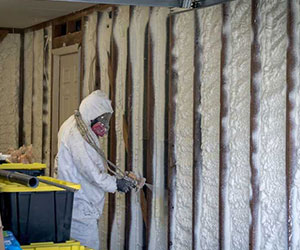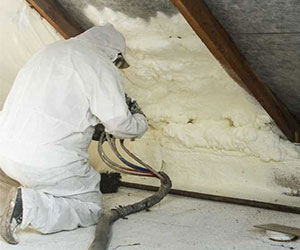As a Maryland resident, you know the struggle of keeping your home comfortable throughout our extreme seasonal shifts. With our unpredictable weather, your energy bills can easily spike in both July and January. But the right insulation product can make all the difference, and one product has emerged as an insulation game-changer, spray foam.
In this post, we’ll explore how spray foam insulation creates an effective solution for maintaining a comfortable and energy-efficient home. We’ll break down the benefits of spray foam, compare costs to traditional fiberglass insulation, address common concerns, and explain why Maryland’s unique climate makes spray foam a smart choice.
So, whether you’re a homeowner looking to save on utilities or a contractor aiming to build better homes, read on to learn why spray foam insulation is a smart investment in Maryland.
 Long-Term Savings and Return on Investment
Long-Term Savings and Return on Investment
As you consider the best type of insulation for your home, think about these key benefits of choosing spray foam insulation:
Insulates and seals in one step
Spray foam has the unique ability to insulate and air seal in one easy step unlike other insulation options.
Reduces heating and cooling costs
With proper air sealing and insulation you can reduce your heating and cooling costs by an average of 15%.
Lightens your HVAC unit’s workload
Spray foam can lower your HVAC energy use by up to 30%.
Long-lasting
Unlike cellulose or fiberglass insulation, spray foam doesn’t degrade over time, eliminating the need for re-insulation.
Increases home value
Spray foam increases your home’s property value thanks to increased energy efficiency and reduced maintenance needs.
Pays for Itself
Spray foam is reported to pay for itself within five years thanks to lower energy bills.
Addressing Common Concerns About Spray Foam
It’s also important to address any concerns or misconceptions you may have about spray foam, such as:
Concern #1 – Cost
While the initial price tag is higher than other insulations, your long-term savings outweigh the upfront investment. Also, unlike other insulations, spray foam eliminates the need for separate air sealing.
Concern #2 – Safety
Spray foam is an expanding foam made from chemicals. When installed it goes through what’s called a curing process, where the chemical’s gases are released. Proper ventilation and safety gear are required during installation and your home should remain unoccupied for 24 hours. After the curing process is completed, your home is 100% safe for you and your family to return to and enjoy.
Concern #3 – Effectiveness
Spray foam expands 30-60 times its size to fill gaps and cracks throughout your home, eliminating air leaks and creating a strong air barrier. Of the two types of spray foam (open cell and closed cell), closed cell spray foam has one of the highest insulation R-values (6.5-7 per inch), compared to fiberglass insulation (R-3 to R-4 per inch).
Concern #4 – Home Ventilation
Because spray foam creates an airtight seal, it’s important for you to incorporate controlled, mechanical ventilation to maintain indoor air quality. These types of ventilation include HRVs (heat recovery ventilators), ERVs (energy recovery ventilators), kitchen range hoods, and bath fans.
Concern #5 – Structural Impact
Closed cell spray foam strengthens your walls and roof, adding durability to your home’s structure. It also resists moisture intrusion, helping to reduce the risk of mold and mildew and water damage.
 How Spray Foam Excels in Maryland’s Climate
How Spray Foam Excels in Maryland’s Climate
Maryland’s Weather Challenges
Our state experiences its fair share of extreme temperatures and weather, from hot, humid summers (80s/90s°F) to cold, snowy winters (20s/30s°F), with some heavy rainfall and Nor’easters thrown in for good measure. That’s why it’s important to have proper insulation, such as spray foam insulation, to keep you comfortable all year long.
Summer Benefits (Hot and Humid)
Spray foam helps you beat the summer heat and humidity by:
- Blocking attic heat gain to keep your upper floors cooler.
- Reducing your AC usage to lower your energy bills.
- Preventing condensation issues and sealing out humidity that can lead to mold and mildew.
Winter Benefits (Cold and Drafty)
Spray foam helps you stay warm and comfy all winter long too by:
- Preventing heat loss which in turn lessens your heating costs.
- Eliminating drafts around windows, doors, and baseboards.
- Preventing ice dams by stopping attic heat escape to keep your roof evenly cold.
- Reducing furnace and heat pump strain, extending your HVAC system’s lifespan.
Year-Round Benefits
Be comfortable all year long with spray foam as it also:
- Maintains stable indoor temperatures by creating an airtight seal.
- Acts as a sound barrier, reducing outside noise.
- Blocks allergens, dust, and pollutants, improving your home’s indoor air quality.
- Enhances flood resilience, as closed cell spray foam resists water damage.
Devere Insulation is Your Baltimore Spray Foam Expert
At Devere Insulation, we have over 35 years of experience providing expert insulation services to our Baltimore area community. Our experienced team deeply understands our local building codes, climate challenges, and the best ways to optimize your home’s energy efficiency. We promise professional installation and high customer satisfaction to ensure your home or residential building project is comfortable and energy efficient year-round. Local builders and homeowners count on us for tailored insulation solutions that include spray foam, cellulose, and fiberglass insulation.
Contact us today to learn more about spray foam insulation and how it can benefit your Baltimore home.
References
VB Insulation – “Spray Foam Insulation vs Fiberglass Insulation Cost Comparison 2024.” VB Insulation Blog. Jul 04, 2024.
vbinsulation.com
Paragon Protection – “Spray Foam Insulation vs. Fiberglass Cost Comparison.” Paragon Protection Insulation Blog.
paragon-protection.com
RetroFoam of Michigan – “Is the Foam Insulation Worth the Cost? Energy Savings Explained.” RetroFoam Blog.
retrofoamofmichigan.com
Responsible House (VA) – “5 Common Misconceptions About Spray Foam Insulation.” ResponsibleHouse.com Blog.
responsiblehouse.com
Foam InSEALators (Mid-Atlantic) – “Mid-Atlantic Weather: Why Attic Spray Foam is Essential for Maryland & Virginia Homes.” (Foam InSEALators Blog, updated June 2024)
insulatewithfoam.com
DeVere Insulation (Baltimore, MD) – “Spray Foam in Baltimore, MD – Insulation Products.” DeVereInsulation.com.
devereinsulation.com
Angi Reviews – “DeVere Insulation Home Performance Reviews.” Angi (Angie’s List) Customer Reviews Page.
angi.com

 Long-Term Savings and Return on Investment
Long-Term Savings and Return on Investment How Spray Foam Excels in Maryland’s Climate
How Spray Foam Excels in Maryland’s Climate